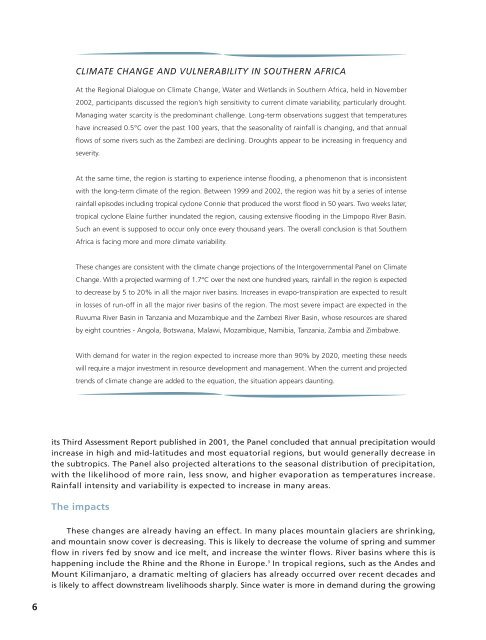Adaptation of water resources management to climate change
Adaptation of water resources management to climate change
Adaptation of water resources management to climate change
Create successful ePaper yourself
Turn your PDF publications into a flip-book with our unique Google optimized e-Paper software.
CLIMATE CHANGE AND VULNERABILITY IN SOUTHERN AFRICAAt the Regional Dialogue on Climate Change, Water and Wetlands in Southern Africa, held in November2002, participants discussed the region’s high sensitivity <strong>to</strong> current <strong>climate</strong> variability, particularly drought.Managing <strong>water</strong> scarcity is the predominant challenge. Long-term observations suggest that temperatureshave increased 0.5°C over the past 100 years, that the seasonality <strong>of</strong> rainfall is changing, and that annualflows <strong>of</strong> some rivers such as the Zambezi are declining. Droughts appear <strong>to</strong> be increasing in frequency andseverity.At the same time, the region is starting <strong>to</strong> experience intense flooding, a phenomenon that is inconsistentwith the long-term <strong>climate</strong> <strong>of</strong> the region. Between 1999 and 2002, the region was hit by a series <strong>of</strong> intenserainfall episodes including tropical cyclone Connie that produced the worst flood in 50 years. Two weeks later,tropical cyclone Elaine further inundated the region, causing extensive flooding in the Limpopo River Basin.Such an event is supposed <strong>to</strong> occur only once every thousand years. The overall conclusion is that SouthernAfrica is facing more and more <strong>climate</strong> variability.These <strong>change</strong>s are consistent with the <strong>climate</strong> <strong>change</strong> projections <strong>of</strong> the Intergovernmental Panel on ClimateChange. With a projected warming <strong>of</strong> 1.7°C over the next one hundred years, rainfall in the region is expected<strong>to</strong> decrease by 5 <strong>to</strong> 20% in all the major river basins. Increases in evapo-transpiration are expected <strong>to</strong> resultin losses <strong>of</strong> run-<strong>of</strong>f in all the major river basins <strong>of</strong> the region. The most severe impact are expected in theRuvuma River Basin in Tanzania and Mozambique and the Zambezi River Basin, whose <strong>resources</strong> are sharedby eight countries - Angola, Botswana, Malawi, Mozambique, Namibia, Tanzania, Zambia and Zimbabwe.With demand for <strong>water</strong> in the region expected <strong>to</strong> increase more than 90% by 2020, meeting these needswill require a major investment in resource development and <strong>management</strong>. When the current and projectedtrends <strong>of</strong> <strong>climate</strong> <strong>change</strong> are added <strong>to</strong> the equation, the situation appears daunting.its Third Assessment Report published in 2001, the Panel concluded that annual precipitation wouldincrease in high and mid-latitudes and most equa<strong>to</strong>rial regions, but would generally decrease inthe subtropics. The Panel also projected alterations <strong>to</strong> the seasonal distribution <strong>of</strong> precipitation,with the likelihood <strong>of</strong> more rain, less snow, and higher evaporation as temperatures increase.Rainfall intensity and variability is expected <strong>to</strong> increase in many areas.The impactsThese <strong>change</strong>s are already having an effect. In many places mountain glaciers are shrinking,and mountain snow cover is decreasing. This is likely <strong>to</strong> decrease the volume <strong>of</strong> spring and summerflow in rivers fed by snow and ice melt, and increase the winter flows. River basins where this ishappening include the Rhine and the Rhone in Europe. 3 In tropical regions, such as the Andes andMount Kilimanjaro, a dramatic melting <strong>of</strong> glaciers has already occurred over recent decades andis likely <strong>to</strong> affect downstream livelihoods sharply. Since <strong>water</strong> is more in demand during the growing6











![View full document [PDF 988.55 KB] - PreventionWeb](https://img.yumpu.com/47733942/1/184x260/view-full-document-pdf-98855-kb-preventionweb.jpg?quality=85)
![View full document (in French) [PDF 4.96 MB] - PreventionWeb](https://img.yumpu.com/47223870/1/184x260/view-full-document-in-french-pdf-496-mb-preventionweb.jpg?quality=85)


![View full document [PDF 25.02 MB] - PreventionWeb](https://img.yumpu.com/44204570/1/190x234/view-full-document-pdf-2502-mb-preventionweb.jpg?quality=85)
